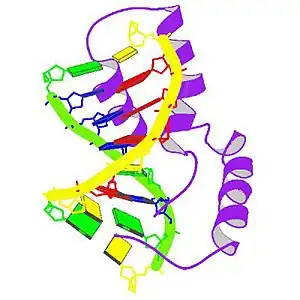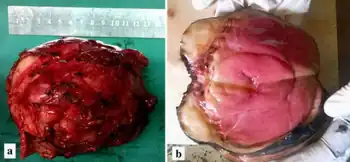XY gonadal dysgenesis
| XY gonadal dysgenesis | |
|---|---|
| Other names: Swyer syndrome | |
 | |
| Protein SRY | |
| Specialty | Medical genetics |
XY gonadal dysgenesis, also known as Swyer syndrome, is a type of hypogonadism in a person whose karyotype is 46,XY. Though they typically have normal female external genitalia,[1] the person has functionless gonads, fibrous tissue termed "streak gonads", and if left untreated, will not experience puberty. Such gonads are typically surgically removed (as they have a significant risk of developing cancer). The typical medical treatment is hormone replacement therapy.[2] The syndrome was named after Gerald Swyer, an endocrinologist based in London.
Signs and symptoms
People with Swyer syndrome are born with external phenotypes typical of females and nonfunctional gonads instead of ovaries or testes. Individuals are most commonly diagnosed during puberty after menstruation fails to occur (primary amenorrhea).[3]
The consequences of Swyer syndrome without treatment:
- Gonads cannot make estrogen, so the breasts will not develop and the uterus will not grow and menstruate until estrogen is administered. This is often given transdermally.
- Gonads cannot make progesterone, so menstrual periods will not be predictable until progestin is administered, usually as a pill.
- Gonads cannot produce eggs, so conceiving children is not possible without intervention. There has been a case of unassisted pregnancy in one woman with XY gonadal dysgenesis, who had a predominantly 46,XY Karyotype - a 46,XY karyotype in peripheral lymphocytes, mosaicism in cultured skin fibroblasts (80% 46,XY and 20% 45,X) and a predominantly 46,XY karyotype in the ovary (93% 46,XY and 6% 45,X) - who gave birth to a 46,XY female with complete gonadal dysgenesis.[4] A woman with a uterus and ovaries but without female gamete is able to become pregnant by implantation of another woman's fertilized egg (embryo transfer).
- Streak gonads with Y chromosome-containing cells have a high likelihood of developing cancer, especially gonadoblastoma.[5] Streak gonads are usually removed within a year or so of diagnosis, since the cancer can begin during infancy.
- Osteopenia is often present[6]
Genetics
Genetic associations of Swyer syndrome include:
| Type | OMIM | Gene | Locus |
|---|---|---|---|
| 46,XY gonadal dysgenesis, complete, SRY-related | 400044 | SRY | Yp11.3 |
| 46,XY gonadal dysgenesis, complete or partial, DHH-related | 233420 | DHH | 12q13.1 |
| 46,XY gonadal dysgenesis, complete or partial, with or without adrenal failure | 612965 | NR5A1 | 9q33 |
| 46,XY gonadal dysgenesis, complete, CBX2-related | 613080 | CBX2 | 17q25 |
| 46,XY gonadal dysgenesis, complete or partial, with 9p24.3 deletion | 154230 | DMRT1/2 | 9p24.3 |
Seven other genes have been identified with probable associations that are as-yet less clearly understood.[7]
Pure gonadal dysgenesis
There are several forms of gonadal dysgenesis. The term "pure gonadal dysgenesis" (PGD) has been used to describe conditions with normal sets of sex chromosomes (e.g., 46,XX or 46,XY), as opposed to those whose gonadal dysgenesis results from missing all or part of the second sex chromosome. The latter group includes those with Turner syndrome (i.e., 45,X) and its variants, as well as those with mixed gonadal dysgenesis and a mixture of cell lines, some containing a Y chromosome (e.g., 46,XY/45,X).
Thus Swyer syndrome is referred to as PGD, 46,XY, and XX gonadal dysgenesis as PGD, 46,XX.[8] People with PGD have a normal karyotype but may have defects of a specific gene on a chromosome.
Pathogenesis
The first known step of sexual differentiation of a normal XY fetus is the development of testes. The early stages of testicular formation in the second month of gestation requires the action of several genes, one of the earliest and most important of which is SRY: the sex-determining region of the Y chromosome. Mutations of SRY account for many cases of Swyer syndrome.
When such a gene is defective, the indifferent gonads fail to differentiate into testes in an XY fetus. Without testes, no testosterone or antimüllerian hormone (AMH) is produced. Without testosterone, the wolffian ducts fail to develop, so no internal male organs are formed. Also, the lack of testosterone means that no dihydrotestosterone is formed and consequently the external genitalia fail to virilize, resulting in normal female genitalia. Without AMH, the Müllerian ducts develop into normal internal female organs (uterus, fallopian tubes, cervix, vagina).
Diagnosis

Due to the inability of the streak gonads to produce sex hormones (both estrogens and androgens), most of the secondary sex characteristics do not develop. This is especially true of estrogenic changes such as breast development, widening of the pelvis and hips, and menstrual periods. As the adrenal glands can make limited amounts of androgens and are not affected by this syndrome, most of these persons will develop pubic hair, though it often remains sparse.
Evaluation of delayed puberty usually reveals elevation of gonadotropins, indicating that the pituitary is providing the signal for puberty but the gonads are failing to respond. The next steps of the evaluation usually include checking a karyotype and imaging of the pelvis. The karyotype reveals XY chromosomes and the imaging demonstrates the presence of a uterus but no ovaries (the streak gonads are not usually seen by most imaging). Although an XY karyotype can also indicate a person with complete androgen insensitivity syndrome, the absence of breasts, and the presence of a uterus and pubic hair exclude the possibility. At this point it is usually possible for a physician to make a diagnosis of Swyer syndrome.
Related conditions
Swyer syndrome represents one phenotypic result of a failure of the gonads to develop properly, and hence is part of a class of conditions termed gonadal dysgenesis. There are many forms of gonadal dysgenesis.
Swyer syndrome is an example of a condition in which an externally unambiguous female body carries dysgenetic, atypical, or abnormal gonads. Other examples include complete androgen insensitivity syndrome, partial X chromosome deletions, lipoid congenital adrenal hyperplasia, and Turner syndrome.
Treatment

Upon diagnosis, estrogen and progestogen therapy is typically commenced, promoting the development of female characteristics.
Hormone replacement therapy can also reduce the likelihood of osteoporosis.[1]
Individuals with this condition are at increased risk for gonadal tumors (gonadoblastoma), therefore should have surgical intervention[10]
Epidemiology
A 2017 study estimated that the incidence of Swyer syndrome is approximately 1 in 100,000 females.[11] Fewer than 100 cases have been reported as of 2018. There are extremely rare instances of familial Swyer syndrome.[12]
History
Swyer syndrome was first described by G. I. M. Swyer in 1955 in a report of two cases.[12]
Society and culture
People with XY gonadal dysgenesis:
References
- 1 2 "Swyer Syndrome". MedlinePlus Genetics. Archived from the original on 19 December 2021. Retrieved 10 January 2022.
- ↑ Massanyi EZ, Dicarlo HN, Migeon CJ, Gearhart JP (29 December 2012). "Review and management of 46,XY disorders of sex development". J Pediatr Urol. 9 (3): 368–379. doi:10.1016/j.jpurol.2012.12.002. PMID 23276787.
- ↑ "Swyer syndrome". Archived from the original on 9 October 2021. Retrieved 10 January 2022.
- ↑ Dumic, Miroslav; Lin-Su, Karen; Leibel, Natasha I.; Ciglar, Srecko; Vinci, Giovanna; Lasan, Ruzica; Nimkarn, Saroj; Wilson, Jean D.; McElreavey, Ken; New, Maria I. (1 January 2008). "Report of Fertility in a Woman with a Predominantly 46,XY Karyotype in a Family with Multiple Disorders of Sexual Development". The Journal of Clinical Endocrinology & Metabolism. 93 (1): 182–189. doi:10.1210/jc.2007-2155. PMC 2190741. PMID 18000096.
- ↑ Eh, Zheng; Liu, Weili (June 1994). "A familial 46 XY gonadal dysgenesis and high incidence of embryonic gonadal tumors". Chinese Journal of Cancer Research. 6 (2): 144–148. doi:10.1007/BF02997250. S2CID 84107076. Originally published in Chinese as E, Z; Xu, XL; Li, C; Gao, FZ (May 1981). "家族性XY型性腺发育不全和高发胚胎性肿瘤研究:II.XY型性腺发育不全姐妹中第4人继发无性细胞瘤报告和细胞遗传学检查" [A familial XY gonadal dysgenesis causing high incidence of embryonic gonadal tumors- a report of the fourth dysgerminoma in sibling suffering from 46, XY gonadal dysgenesis]. Zhonghua Zhong Liu Za Zhi (in 中文). 3 (2): 89–90. PMID 7307902. Archived from the original on 22 April 2021. Retrieved 10 January 2022.
- ↑ Michala, L.; Goswami, D.; Creighton, SM; Conway, GS (2008). "Swyer syndrome: Presentation and outcomes". BJOG: An International Journal of Obstetrics and Gynaecology. 115 (6): 737–741. doi:10.1111/j.1471-0528.2008.01703.x. PMID 18410658. S2CID 11953597. Archived from the original on 20 April 2021. Retrieved 10 January 2022.
- ↑ Kremen J, Chan YM, Swartz JM (January 2017). "Recent findings on the genetics of disorders of sex development". Curr Opin Urol. 27 (1): 1–6. doi:10.1097/MOU.0000000000000353. PMC 5877806. PMID 27798415.
- ↑ Bomalaski, M. David (February 2005). "A practical approach to intersex". Urologic Nursing. 25 (1): 11–8, 23, quiz 24. PMID 15779688. Archived from the original on 9 October 2021. Retrieved 10 January 2022.
- ↑ McCann-Crosby, Bonnie; Mansouri, Roshanak; Dietrich, Jennifer E.; McCullough, Laurence B.; Sutton, V. Reid; Austin, Elise G.; Schlomer, Bruce; Roth, David R.; Karaviti, Lefkothea; Gunn, Sheila; Hicks, M. John; Macias, Charles G. (2014). "State of the art review in gonadal dysgenesis: challenges in diagnosis and management". International Journal of Pediatric Endocrinology. 2014 (1): 4. doi:10.1186/1687-9856-2014-4. ISSN 1687-9848.
- ↑ "Swyer syndrome | Genetic and Rare Diseases Information Center (GARD) – an NCATS Program". rarediseases.info.nih.gov. Archived from the original on 16 December 2021. Retrieved 14 January 2022.
- ↑ Witchel, Selma Feldman (April 2018). "Disorders of Sex Development". Best Practice & Research. Clinical Obstetrics & Gynaecology. 48: 90–102. doi:10.1016/j.bpobgyn.2017.11.005. ISSN 1521-6934. PMC 5866176. PMID 29503125.
- 1 2 Banoth M, Naru RR, Inamdar MB, Chowhan AK (May 2018). "Familial Swyer syndrome: a rare genetic entity". Gynecol. Endocrinol. 34 (5): 389–393. doi:10.1080/09513590.2017.1393662. PMID 29069951. S2CID 4452231.
- ↑ "Mami Y Yo y Mi Gallito, by Director Arisleyda Dilone – Intersex Campaign for Equality". www.intersexequality.com. Archived from the original on 9 October 2021. Retrieved 27 March 2021.
- ↑ "Ex-Olympian Stella Walsh legally a woman". Sarasota Journal. 12 February 1981. Archived from the original on 10 August 2021. Retrieved 21 July 2014.
Further reading
- Stoicanescu D, Belengeanu V, et al. (2006). "Complete gonadal dysgenesis with XY chromosomal constitution". Acta Endocrinologica (Buc). 2 (4): 465–70. doi:10.4183/aeb.2006.465. Archived from the original on 31 July 2020. Retrieved 10 January 2022.
External links
| Classification |
|---|